| Ships
in Port Jackson were bedecked with bunting;
hooters sent eerie wails echoing across the water; thousands lined
streets and foreshores waving flags and singing Empire songs.
People in Sydney on 8
August 1900 were patriotically excited! They were witnessing the
departure of the Australian Naval Contingent, whose destination was
China - there to "contribute aid to the British portion of an
expedition which had as its object, the restoration of order and
tranquillity".
So the ladies waved
lacy handkerchiefs; brass bands played, and four hundred and eighty men
embarked aboard the hastily converted Aberdeen liner Salamis. The ship
was delayed for farewells and speeches but by nightfall had cleared the
Heads-a carrier pigeon bringing news that all was well.
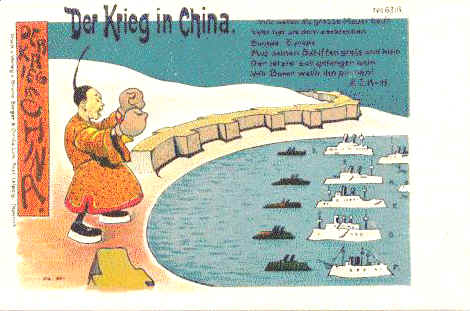
In far-off China chaos
reigned. An immense secret society-dubbed "The Boxers"-had
arisen. Tremendously powerful, well armed, fanatical-backed by the
Empress Dowager herself-the rebels launched a campaign of terror aimed
at the expulsion from China of all foreigners and foreign influence.
Riots took place in many parts, legations were besieged, missionaries
murdered. Especially was "Boxerism" aimed at the "British
clique".
The position was
serious. British interests were threatened and citizens were suffering.
Vice-Admiral Sir E. H. Seymour and his force of two thousand three
hundred men were in a state of siege at Tientsin. The press published
strong editorials-and even verse such as:
"The Boxers are making
things willing,
Both plunder and murder their
sport;
All classes of whites they are
killing.
Let's hope their reign will be
short."
On 2 8 June, Sir
William Lyne, then Premier of New South Wales, received a cablegram from
the Colonial Office in London suggesting that vessels of the Australian
Squadron be sent to China to take part in the hostilities. Public
feeling was running high at the outrages and the Government readily
agreed to the proposal.
Further, it offered for active service
a contingent of the Naval Brigade which had been intended for South
Africa. This offer was immediately accepted by the War Office. Three
vessels, H.M.S. Wallaroo, H.M.S. Mohawk and H.M.S. Lizard - all of
shallow draft suitable for use in river warfare - left for China early
in July. Then began preparations to equip and dispatch the force.
The New South Wales portion amounted
to two hundred and sixty under command of Captain Francis Hixson, RN,
while in Victoria volunteers were called from the naval forces serving
in Cerberus and the Victorian Naval Brigade, Militia. This force was
commanded by Captain Frederick Tickell. South Australia, meanwhile, had
offered the gunboat Protector; but only after considerable indecision
was the offer accepted. The ship finally left Sydney on 11 August -
complete with seventy-five rounds per gun!
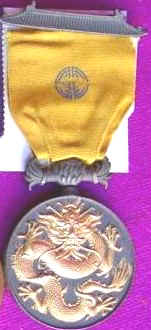 |
The Order of the
Dragon China 1900 |
 |
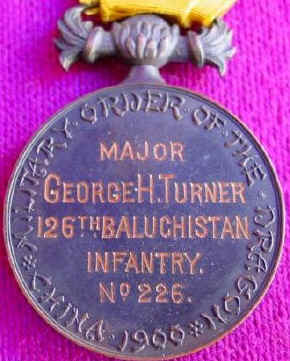 |
Later she was employed almost entirely
in the Gulf of Pechili carrying dispatches and doing patrol work.
Arriving at Hong Kong on 26 August, the contingent became portion of the
"British Contingent Field Force in China". Here Hixson handed
over command to Lieutenant Gillespie, and the unit was ceremoniously
inspected by the Naval Officer-in-Charge at Woosung.
At Tientsin, after heavy fighting, the
British garrison had been relieved, and the Australians found themselves
installed in the battered city. Fifty men, under Captain Hixson, were
placed on duty in the Lama temple; another fifty were allotted to guard
the British Legation, with the remainder at city headquarters. The work
was unspectacular to the adventurous Australians, who policed and
guarded and patrolled in surrounding villages.
But it was a strange land-and
dangerous-this China in revolt. In September, however, a company of the
Victorian members were chosen as part of a punitive expedition organized
by General Alfred Gaselee, whose object was a combined attack on Pao-Ting-Fu.
Moving off from Peking, it was
intended that the force should consist of British, French, German,
Russian and Italian troops. The British were prepared to start at once,
but the German arrangements were incomplete and there seemed every
prospect of a long delay before a start could be made.
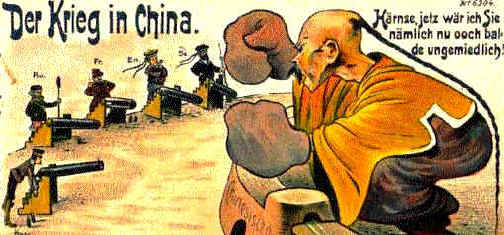
A German cartoon from that time.
Then news arrived of a
proposed almost identical move by the French, and plans were altered to
combine the two expeditions into one force which would converge on the
objective from two different directions. Command of the column to move
from Tientsin was given to Major-General Balliard of the French army,
while General Gaselee assumed command of the force moving from Peking,
and also became supreme commander at the junction of the columns in the neighbourhood
of Pao-Ting-Fu.
The Australians were
included in the force known as "The Tientsin Column", and in
addition to the company of troops they carried supplementary armament in
the form of two Maxim and one 12-pounder naval gun. Numerically stronger
than the Peking force, this column comprised elements of artillery,
engineers, pioneers, cavalry and infantry British, German, French,
Italian and Australian. Truly a mixed gathering!
Both forces started
out on 12 0ctober. The Peking men went by road direct to Pao-Ting-Fu,
while the Tientsin column marched by three roads in a roundabout route.
No opposition was encountered during the march - the Chinese apparently
taking good care to avoid such a well-organized and businesslike force.
The march from Peking was accomplished in seven days. The Australians,
however, were delayed, as the route they followed had proved much longer
and more difficult than was expected. They eventually reached
Pao-Ting-Fu on 21 October.
General Gaselee's plan
for an "attack" on the town did not materialize, for the
columns were met outside the gates by the Chief Magistrate and other
officials. The general conferred with these personages, and next day
rode through the streets accompanied by his staff.
Tie town was divided
into four districts or zones and the French, German and Italian
commanders marched in and occupied their respective areas. But the
British - distrustful and cautious at the quiet entry - remained outside
and camped to the north of the town. General Gaselee, however, moved his
headquarters into the north-west section allotted to the British. A
strong force of "police" went with him, and a British guard
held the north gate.
Life in the town was
not pleasant-or safe. Tension was high. The troops saw massacre, unrest,
rioting and typical Eastern cruelty among the Boxers and inhabitants;
but the measures taken by General Gaselee soon proved to the rebels that
risings do not pay!
Things quietened
suddenly, and the general decided to withdraw his troops-as did the
Italian commander. Some French and Germans were retained as the garrison
force.
The plan was for the
troops from Peking to return on a wide front by three roads-different
from those used on the march south-and the British from Tientsin were
also to return by a different route with the object of attacking Boxer
villages which "required to be punished".
On 27 October the
British troops started back to Tientsin, arriving there on 6 November.
During the trip, they duly "punished" many villages,
destroying arms and ammunition, seizing stores and cattle, and blowing
up vast quantities of gunpowder discovered aboard river junks. The
troops retuning to Peking employed similar tactics.
General Gaselee
returned direct to Tientsin, and declared the expedition successful. As
a direct result, the Allies' show of might and determination caused the
virtual cessation of all active military operations in North China.
It had been clearly
proved that there was no Boxer force in the field capable of - and
courageous enough to - successfully accomplish their sworn cause. The
Boxer bands were demoralized and dispersed. Those who still resisted
were hunted down by the soldiery.
Towards the end of
October British troops were ordered to be withdrawn from North China,
and winter saw two hundred and thirty men of the New South Wales
contingent established at Peking; while at Tientsin the Victorians
formed part of the garrison. Remainder of the force was scattered about
in various localities doing various jobs.
By now practically
nothing in the way of operations was going on, although small patrols
were constantly moving about the country searching out isolated
trouble-makers. It was too cold for the mass movement of troops. The
Australians, therefore, had to settle down to the "odd jobs"
until 25 March 1901, when they were relieved by Royal Welch Fusiliers
from Hong Kong.
Thus began the return
home. The force of "handy men" had lived up to the name coined
by Australian newspapers. They were used as soldiers, as policemen, as
guards and ticket collectors on railways. High quarters praised their
"usefulness" in eulogistic letters and speeches.
"You have been
called upon at the shortest notice to provide men for all kinds of
detached work," said Lieutenant-Colonel J. Swann in a letter of
thanks before the men left Tientsin. "Individual intelligence and
handiness alone could command success; and never once have you failed to
have just the men ready for the job-and never once have you failed to
justify, and more than justify, your selection."
The Mayor and Council
of Tientsin also thanked the Australians, who were each given an
illuminated souvenir of the contingent's visit to North China. In
addition the Council granted fifteen hundred dollars to be divided among
the men who served in police and fire brigades connected with the city.
|
All officers and men
who were employed in North China and in the valley of the Yangtze Kiang
between 11 June and 31 December 1900 received the "China Medal 1900".
The medal bore, on the obverse, the head of Queen Victoria; while the
reverse showed the Royal Arms and a trophy of weapons. Around the top
circumference was the inscription:
The word China appeared at the bottom, and the round medal of silver was
suspended by a crimson ribbon with yellow edges.
|
|
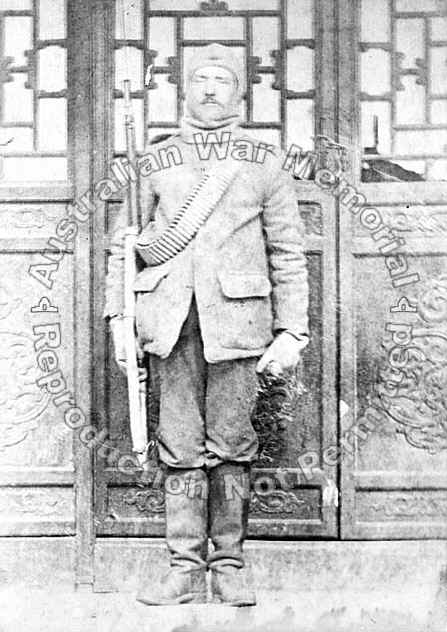
|
Peking.
c. 1900-1901.
An Australian
soldier on guard wearing a Canadian uniform. An ammunition belt is
slung around his body and he is holding a rifle with a
bayonet.
(From the H. E. Lofts collection)
|
During the six months,
the contingent suffered only seven casualties - one of whom was Staff
Surgeon J. J. Steele, who died at Peking on 10 November.
The contingent left
Tientsin at the end of March on the transport Chingtu, and arrived at
Sydney on 25 April. Trouble started here when a member named Symons
became a suspected case of smallpox. The ship was placed in
quarantine-despite typical Australian expressions of disgust! It was not
until eight days later that a hundred and forty-six of the men whose
early vaccinations had "taken" - were allowed to leave the
ship and land at Circular Quay. There followed a short march through
city streets to the drill hall at Fort Macquarie, where they were
welcomed home by the Premier, the Honourable John See.
The Victorians left
Sydney by special train and arrived in Melbourne next day. They were
accorded a warm welcome-arriving as they did when the city was en fete
for the visit of the Duke and Duchess of Cornwall and York. The men were
entertained at Victoria Barracks and later given leave until paying off
arrangements were completed.
The unfortunate
remainder - the success of whose vaccinations was doubtful - landed at
the Quarantine Station and began an enforced wait of a further two
weeks!
So the China
Contingent came home. They saw little of the expected active
campaigning, but the presence of Australians on such a remote stage as
North China produced what was termed "an excellent political
effect".
"They were an
object lesson in patriotism which inspired all parts of the British
Empire."
BRUCE HARDING (Second
A.I.F.)
AS YOU WERE 1946 by the
AWM
|